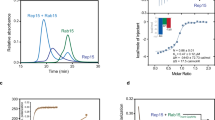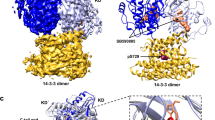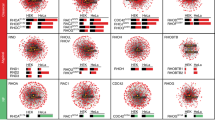Abstract
Heterotrimeric guanine-nucleotide-binding proteins (G proteins) are signal transducers that relay messages from many receptors on the cell surface to modulate various cellular processes1,2,3,4. The direct downstream effectors of G proteins consist of the signalling molecules that are activated by their physical interactions with a Gα or Gβγ subunit. Effectors that interact directly with Gα12 G proteins have yet to be identified5,6. Here we show that Gα12 binds directly to, and stimulates the activity of, Bruton's tyrosine kinase (Btk) and a Ras GTPase-activating protein, Gap1m, in vitro and in vivo. Gα12 interacts with a conserved domain, composed of the pleckstrin-homology domain and the adjacent Btk motif, that is present in both Btk and Gap1m. Our results are, to our knowledge, the first to identify direct effectors for Gα12 and to show that there is a direct link between heterotrimeric and monomeric G proteins.
This is a preview of subscription content, access via your institution
Access options
Subscribe to this journal
Receive 51 print issues and online access
$199.00 per year
only $3.90 per issue
Buy this article
- Purchase on Springer Link
- Instant access to full article PDF
Prices may be subject to local taxes which are calculated during checkout







Similar content being viewed by others
References
Gilman, A. Gproteins: transducers of receptor-generated signals. Annu. Rev. Biochem. 56, 615–649 (1987).
Bourne, H. R., Sanders, D. A. & McCormick, F. The GTPase superfamily: a conserved switch for diverse cell functions. Nature 348, 125–132 (1990).
Simon, M. I., Strathmann, M. P. & Gautum, N. Diversity of G proteins in signal transduction. Science 252, 802–808 (1991).
Clapham, D. E. & Neer, E. J. Gprotein βγ subunits. Annu. Rev. Pharmacol. Toxicol. 37, 167–203 (1997).
Strathmann, M. P. & Simon, M. I. Gα12 and Gα13 subunits define a fourth class of G protein α subunits. Proc. Natl Acad. Sci. USA 88, 5582–5586 (1991).
Dhanasekaran, N. & Dermott, J. M. Signaling by the G12 class of G proteins. Cell. Signal. 8, 235–245 (1996).
Bence, K., Ma, W., Kozasa, T. & Huang, X.-Y. Direct stimulation of Bruton's tyrosine kinase by Gq-protein α-subunit. Nature 389, 296–299 (1997).
Vihinen, M. et al. BTKbase: a database of XLA-causing mutations. Immunol. Today 16, 460–465 (1995).
Vihinen, M., Nilsson, L. & Smith, C. I. E. Tec homology (TH) adjacent to the PH domain. FEBS Lett. 350, 263–265 (1994).
Maekawa, M., Nakamura, S. & Hattori, S. Purification of a novel ras GTPase-activating protein from rat brain. J. Biol. Chem. 268, 22948–22952 (1993).
Maekawa, M. et al. Anovel mammalian Ras GTPase-activating protein which has phospholipid-binding and Btk homology regions. Mol. Cell. Biol. 14, 6879–6885 (1994).
Gaul, U., Mardon, G. & Rubin, G. M. Aputative Ras GTPase activating protein acts as a negative regulator of signaling by the Sevenless receptor tyrosine kinase. Cell 68, 1007–1019 (1992).
Cullen, P. J. et al. Identification of a specific Ins(1,3,4,5)P4-binding protein as a member of the GAP1 family. Nature 376, 527–530 (1995).
Yamamoto, T., Matsui, T., Nakafuku, M., Iwamatsu, A. & Kaibuchi, K. Anovel GTPase-activating protein for R-Ras. J. Biol. Chem. 270, 30557–30561 (1995).
Voyno-Yasenetskaya, T. A., Faure, M. P., Ahn, N. G. & Bourne, H. R. Gα12 and Gα13 regulate extracellular signal-regulated kinase and c-Jun kinase pathways by different mechanisms in COS-7 cells. J. Biol. Chem. 271, 21081–21087 (1996).
Taylor, S. J. & Shalloway, D. Cell cycle-dependent activation of Ras. Curr. Biol. 6, 1621–1627 (1996).
Offermanns, S., Laugwitz, K.-L., Spicher, K. & Schultz, G. Gproteins of the G12 family are activated via thromboxane A2 and thrombin receptors in human platelets. Proc. Natl Acad. Sci. USA 91, 504–508 (1994).
Harhammer, R. et al. Distinct biochemical properties of the native members of the G12 G-protein subfamily. Biochem. J. 319, 165–171 (1996).
Hirata, M. et al. Cloning and expression of cDNA for a human thromboxane A2receptor. Nature 349, 617–620 (1991).
McCormick, F. Activators and effectors of ras p21 proteins. Curr. Opin. Genet. Dev. 4, 71–76 (1994).
Kozasa, T. & Gilman, A. G. Purification of recombinant G proteins from Sf9 cells by hexahistidine tagging of associated subunits. J. Biol. Chem. 270, 1734–1741 (1995).
Wan, Y., Kurosaki, T. & Huang, X.-Y. Tyrosine kinases in activation of the MAP kinase cascade by G-protein-coupled receptors. Nature 380, 541–544 (1996).
Wan, Y. et al. Genetic evidence for a tyrosine kinase cascade preceding the mitogen-activated protein kinase cascade in vertebrate G protein signalling. J. Biol. Chem. 272, 17209–17215 (1997).
Langhans-Rajasekaran, S. A., Wan, Y. & Huang, X.-Y. Activation of Tsk and Btk tyrosine kinases by G protein βγ subunits. Proc. Natl Acad. Sci. USA 92, 8601–8605 (1995).
Zhang, J. J. et al. Two contact regions between Stat1 and CBP/p300 in interferon γ signaling. Proc. Natl Acad. Sci. USA 93, 15092–15096 (1996).
Schwer, B. & Guthrie, C. PRP16 is an RNA-dependent ATPase that interacts transiently with the spliceosome. Nature 349, 494–499 (1991).
Acknowledgements
We thank S. Taylor and D. Shalloway for the pGEX-RBD plasmid; M. Liu and M.Simon for the Gα12 plasmid; and M. Gershengorn, L. Levin, W. Lowry and T. Maack for reading the manuscript. Some of the Sf9 cells were cultured in the National Cell Culture Center. This work was supported by grants from the NIH, the NSF, and the American Heart Association. X.-Y.H. is a Beatrice F.Parvin Investigator of the American Heart Association New York City affiliate.
Author information
Authors and Affiliations
Corresponding author
Rights and permissions
About this article
Cite this article
Jiang, Y., Ma, W., Wan, Y. et al. The G protein Gα12 stimulates Bruton's tyrosine kinase and a rasGAP through a conserved PH/BM domain. Nature 395, 808–813 (1998). https://doi.org/10.1038/27454
Received:
Accepted:
Issue Date:
DOI: https://doi.org/10.1038/27454
This article is cited by
-
BTK inhibition results in impaired CXCR4 chemokine receptor surface expression, signaling and function in chronic lymphocytic leukemia
Leukemia (2016)
-
BTK inhibitors in chronic lymphocytic leukemia: a glimpse to the future
Oncogene (2015)
-
Targeting Bruton's tyrosine kinase in B cell malignancies
Nature Reviews Cancer (2014)
-
G protein alpha 12
AfCS-Nature Molecule Pages (2010)
-
G Protein regulation of MAPK networks
Oncogene (2007)
Comments
By submitting a comment you agree to abide by our Terms and Community Guidelines. If you find something abusive or that does not comply with our terms or guidelines please flag it as inappropriate.



